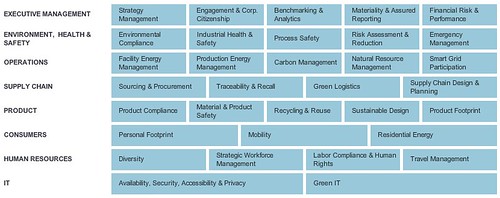Peter Graf, SAP’s Chief Sustainabilty Officer, and Scott Bolick, VP Sustainability, spoke to a group of bloggers and analysts at a sustainability roundtable today. Graf started with SAP’s definition of sustainability: increase short and long-term profitability by holistically managing economic, social and environmental risks and opportunities. Sustainability changes business processes drastically, especially those processes that span multiple organizations. SAP is leading by example, improving their own internal efficiencies by enacting sustainability measures such as reducing carbon emissions, but also see their software as an enabler for other organizations to implement sustainable solutions. SAP has a number of customers that are using SAP solutions across five general areas of sustainability: carbon impact, environmental compliance, people health and safety, product safety, and sustainability performance management. In addition to cost savings, sustainability can become a recruitment factor: younger people, in particular, want to work for a company that shares their environmental concerns.
They have made sustainability a focus of presentations at this conference, but also have made a number of sustainable logistics choices at the actual event. They have a new sustainability report that has already become hugely popular for fostering stakeholder dialog, and a sustainability map structured by line of business and business case. They are the first technology company to join the Sustainability Consortium, and we heard about acquisitions, customers and partners that are all focused on sustainability.
SAP sees Business Objects Explorer as being a key tool for helping to identify areas for sustainability; for example, providing an analytical view into office and plant costs to determine where unusual electricity consumption is occurring. SAP uses this internally for their own sustainability data analysis, and had a nice spiffy iPad version to show us, since you can’t have a conference these days without showing an iPad at least once. Analytics, especially real-time dashboards that allow for drilling into data, have been gaining popularity in a number of areas lately: we’ve seen everything from academic papers to mainstream reports in The Economist discussing analytics, and this is just one more high-profile example.
Bolick then took the stage to talk about their new sustainability report in more detail; if you want more information on everything from the basic definitions of sustainability to measuring performance to more complex solutions, check it out online. This is not a static PDF that you’ll never read; this is an interactive website that includes up-to-date SAP sustainability news and social content, as well as their own analytics tools allowing a drill-down into performance (e.g., carbon footprint reduction) numbers. The sustainability map is pretty interesting (under the Solutions tab), showing all the different targets for sustainability, organized by who is responsible for solutions in that area.
There’s a pretty strong commitment to corporate transparency from SAP: they show both positive and negative performance measures in the report, such as the significant drop in employee engagement. This would make a great tool for other companies to measure and publish their sustainability measures; Tom Rafferty asked when they planned to productize a sustainability report generator for their customers, but since this is currently pretty specific to SAP’s operations, it’s not clear how easy that would be to do; they spoke about the potential to provide at least part of this as an on-demand solution, as well as providing benchmark performance data to help companies measure their “return on sustainability”.
The conversation came back to business processes, and the impact of IT in enabling more efficient and sustainable processes. There’s a key piece missing, however: their focus today was on analyzing sustainability performance data for human consumption, but I’m not hearing anything about using those analytics as events to feed back into any sort of automated process optimization, where optimization in this sense would be sustainability performance optimization rather than the usual type of process optimization that we do. I suspect that much of this sort of optimization is still fairly manual due to the nature of the measurement and what is required to optimize it (e.g., number of women in the workforce in order to create a more sustainable workforce), and also since many of these are such high level measures that they don’t relate to just a single process: optimizing sustainability performance is up in the first row of your enterprise architecture, and over in those columns dealing with motivation, and we haven’t yet worked out all the transformations needed to map that down to the nitty-gritty of actual business processes and rules.
Credit to Jon Reed for the title of this blog post; I was in the blogger area of the communications center (did I mention that SAP’s treatment of media in general and social media in particular really rocks?) and I told him my impressions of the roundtable and how I thought they should have more of a focus on a round-trip push back to BPM, and he popped out the phrase “the sustainability-BPM connection”. Thanks, Jon!


Hi Sandy,
Please, have you seen more recent works on this direction (Sustainability-BPM)?
Thanks,
Hugo Vega (twitter: SOA8v)